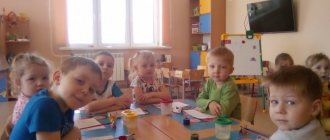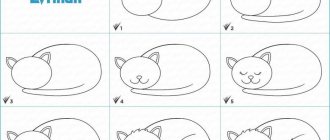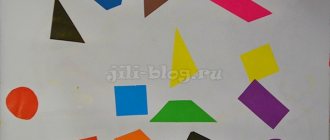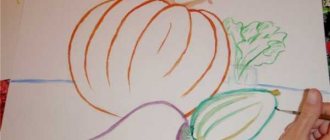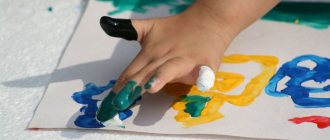Teaching drawing to a child 2-3 years old
You need to get the most out of the image. The child first draws with vertical, wavy lines. He still has difficulty coloring objects.
First line technique
First you need to introduce your child to drawing subjects. The hand should hold the pencil correctly, the brush should be rinsed in a glass of water. The best way to learn is through demonstration. You can sit down at the table next to your baby, take a pencil and start drawing your drawing, or try to control your child’s hand. You need to take more paper to spread it all over the table.
Important! It should be understood that drawing with children 2-3 years old starts small. To begin with, you need to be content with incomprehensible lines.
The benefits of drawing for child development
Drawing helps you understand the world faster, but this is not the only advantage of such activities, there are others:
- development of fine motor skills of the hands. At 2 years old, the baby learns to hold objects and direct them correctly. Children become smarter and their speech develops faster. Psychologists describe the presence of reflex points on the fingers, from which the signal enters the brain. From their stimulation mental abilities develop;
- the emergence of purposefulness;
- figurative thinking. In the future, for memorization, it is important to associate objects with images;
- emphasizing attention and imagination;
- development of mathematical abilities and logic. Shapes of objects, comparison, equality - these are simple concepts in mathematics that are ingrained in childhood.
The role of drawing in the development of a child
Drawing is directly related to imagination, speech, mental activity and perception of the surrounding reality. Fine art enhances and organizes these mental functions, helping the little artist to systematize his idea of the surrounding reality.
The more actively a child understands the world through games, the better he draws, developing his creative abilities, and therefore developing his intellect. Giving your baby a pencil and paper is not only a way to keep him busy for a while.
The benefits of drawing for children are undeniable and scientifically proven, since artistic activities:
- give joy. Drawing becomes a hobby for the child, which brings great pleasure, as it gives freedom of expression;
- develop perseverance and accuracy. Holding a pencil in hand is not an easy task for a child, and depicting a specific object is a painstaking and difficult task. While performing it, the baby goes through an important process - the development of fine motor skills: the better he masters this stage, the faster speech will develop;
- train memory, attention, improve spatial imagination;
- help to cope with emotions, making the baby happier and freer, because through drawing the baby “splashes out” on paper his feelings, which due to age he cannot express through speech;
- develop creative potential. Creating a drawing or painting requires a child to have an individual vision of objects, requires a creative approach to the creative process, the ability to admit one’s mistakes and, as a result, create something unique;
- calm the psyche: it is especially useful to draw for children prone to whims and neuroses;
- help reveal individuality. When drawing, a child feels like a creator, an individual, which makes him more confident and has a beneficial effect on self-esteem.
From a child's drawing you can understand who its author is - a boy or a girl. This is a scientific fact. Girls have better developed verbal and logical thinking, emotions, and attention to detail. They are focused on a specific image, they like to draw princesses and animals. Boys are distinguished by spatial imagination, so they usually depict dynamic pictures - battles with equipment and weapons.
Only a child psychologist can interpret the drawing and only taking into account the child’s own comments. If a child prefers to depict objects in black, this does not mean that he is depressed, but simply an association with his father’s car.
How to interest a child
In any business, the most important thing is interest. You can get used to drawing if your child loves it. There are several ways:
- Emotional perception of an adult. The parent should praise and rejoice. Through the emotions of an adult, you can achieve success in drawing a child.
- Turn the lesson into a game. You can come up with a game plot that will be interesting to the baby. For example, a bunny asks for a carrot, you need to draw it. The game should be filled with meaning. You can conduct a dialogue, show the child a toy hare.
- Process. We must not forget about the most important thing. The first drawing will definitely impress the little one, so there should be a lot of different paints, pencils, and felt-tip pens on the table. Many new objects are the main attribute of the first “picture”. The second and third pictures will be even better.
Children's finger gymnastics for kindergarten
Image techniques
To understand how to teach a child to draw at 3 years old, you need to consider drawing techniques. From a variety of options, you can choose the most effective ones for your baby.
Poking technique
- Poking drawing. The adult selects the plot of the template that needs to be supplemented. It is recommended to choose a semi-dry, hard bristle brush with gouache paint. A felt-tip pen will also work. You can color a snowman, animals, plants. This technique will help you learn how to color.
- Dipping. For this method it is better to choose paints. The child holds the brush diagonally closer to the table (in the vertical poke technique) and leaves brush marks. These could be tracks of an animal, lights on a Christmas tree, patterns on clothes. You can print a black and white picture or draw it yourself.
- Fingerprints. Apply a little paint to a white sheet and show how to paint with your fingers. You should be careful when choosing paints, because babies’ skin is very delicate and susceptible to allergies and irritations. You should choose gouache and watercolor.
- Drawing with lines. This is a more complex stage that needs to be introduced after studying the first three techniques described above.
Examples of custom drawing
The methods can be adapted for younger and older children.
Drawing on sand/semolina with a finger/stick.
All kids like this method. It develops fine motor skills and tactile sensitivity. If possible, build something like a light cube - a box with a transparent lid with a light bulb inside. Drawing on a thin layer of sand on such a box is very entertaining.
Coloring crafts made from salt dough.
After modeling, you may end up with various figures that your child will be happy to paint. If he still doesn’t understand well that mixing all the colors in a row will only result in “dirt,” give him one jar of paint at a time. Then, when the drawing on the figure dries, take out the next color.
Drawing with crayons on stones.
If you go to the sea or to a rocky beach in the summer, be sure to take a box of crayons with you. While you are sunbathing, your baby will have something to do - coloring rock candy.
Drawing with colored ice.
This activity is especially relevant for hot summer days. Freeze ice cubes by adding colorful paints to the water (regular watercolor will do). Place your child on a piece of Whatman paper and give him a container of colored ice. Having coped with the task of removing the cold cubes, he will move them around the paper until they melt.
Use of available materials.
Draw with everything you can get your hands on! (Well, or almost everyone...) Study the result, comment, discuss with your child. You can dip glass balls in paint and roll them inside the box: let the child tilt the box to the sides and follow the multi-colored trace. You can use a fork to draw a lion's mane, spruce paws, or hedgehog needles. And so on!
If your son is passionate about cars, dip the wheels in paint and let him “drive” his vehicle on a piece of whatman paper. And you help him draw a road, trees along the road, a traffic light and a pedestrian crossing.
Drawing as part of the game.
Combine drawing with other activities: appliqué, paper crafts, and natural materials. Maybe you have fabric paints at home? Buy a white T-shirt and let your child design it himself! You can print his palms on a T-shirt - not only will it be a drawing activity, but it will also be a memory for many years.
Workspace organization
The workplace should both attract and teach organization.
- First you need to take care of the child's health. The table and chair included must be adjusted to the height of the child. The back is rigid for correct posture. During work, you need to monitor his body position, carefully guide him without knocking him out of his work.
- Interesting design. It’s always nice when your child’s desk matches the interior of the room, but you shouldn’t forget about visual perception. The workplace should attract the little one.
- Before drawing with children 2-3 years old, you need to prepare a table. It is advisable to do this in front of a child. Carefully laid out paints and pencils will teach him order. After classes you need to clean everything up. Again, you can come up with a game that will teach your child to keep order, then in the future during school lessons he will keep his workplace clean.
Workplace
Before starting drawing lessons, set up a comfortable workspace for your child. Drawing on a stack of books in the mother's arms will either discourage the child from drawing at all, or will encourage him to choose a more comfortable place, for example, on the wall or on the carpet.
For the little ones, choose children's tables with adjustable heights, as well as adjustable chairs. You shouldn’t immediately buy your child an easel—not everyone likes to draw on it. But many people strive to “decorate” their wallpaper with a pattern, so a place for painting can also be arranged on the wall. For example, hang a large sheet of Whatman paper or a special board for chalk.
In any case, it is your child who should choose the material for drawing, and not you, otherwise, if the child doesn’t like something, you can discourage all desire for further creativity.
How to teach a 3 year old child to draw
The first image should interest the child so that next time he starts drawing again. To teach a 3-year-old child to draw, you can use one of the techniques.
Hatching on coloring books
- The coloring technique will help your child choose the right colors. You need to help him not go beyond the line by coloring two or three objects yourself. You need to start with simple coloring books: a house, a car made of shapes, a flower.
- Technique of improvised means. You can try drawing with toy vehicles or threads. You can lay out patterns with them and then paint them.
- Drawings that develop mathematical skills: lines, ovals, circles. These can be provided as templates. For example, a drawing of a boy with colorful balls.
Book by L. Peterson on mathematics for preschoolers 6-7 years old
How to draw with children from 2 to 3 years old
Lyubov Mishustina
How to draw with children from 2 to 3 years old
We adults don’t pay much attention to children’s kalya-malya and try to push the child to depict real objects. We want children to start depicting something real as quickly as possible: a circle, a square, a triangle, a cloud, houses, grass. We don’t even suspect that with such desires and advice we are blocking the development in children of the ability to speak figurative language, the ability to draw .
To begin with, I want to highlight the significant differences between the drawings of adults and children.
In their drawings, adults depict reality, a real object. Children under 7-8 years old convey their feelings from an object and express their mental world outside. The similarity is not interesting to the child; he draws his impression of the object.
Typically, these are tactile, motor and visual impressions.
Let's take a close look at the first children's drawings of kala-malya. This is a very important period! our children’s drawing is blocked . And then, as a rule, they grow into adults who do not know how to draw or draw in a formulaic manner (sun, flowers, house, grass)
.
The period of kala-malya or doodle drawing has its own names : chaotic doodles, circular doodles, developed doodles.
1. Chaotic doodles
Up to a year old, the baby picks up a pencil and starts poking it at a piece of paper, rejoicing that it leaves marks. These are the first doodle drawings. At this moment, the child can look around, at his mother, and continue to poke. He makes chaotic scribbles.
The child makes an important discovery for himself: he can leave traces in this world!
If you give the child a piece of paper and a pencil during this period, he will draw the pencil over the piece of paper with interest, not respecting the boundaries. At this stage, he has not yet developed visual-motor coordination (eye-hand)
: the eyes do not follow what the hand is doing, but the hand acts as it turns out.
drawing tool : a soft pencil or felt-tip pen, finger paints, and if your child is still actively exploring the world through his mouth, then a natural dye, such as carrot or beet juice. It is enough to give just one copy, and not a scattering of pencils and markers and a whole album. This will help your child focus on leaving marks rather than trying to taste everything.
And it’s important that mom gives feedback: “Wow, how great!”
,
“How much and beautifully you
drew !” - so that the baby gets the experience of a positive reaction to his actions. Especially for leaving traces.
Any smearing of anything during this period (often porridge on the table, vegetables, pasta)
– part of the experience of leaving traces. Therefore, we carefully respond to such actions, without criticism or negative emotional reactions. We simply help the child finish his food and go do other things so that lunch or dinner does not turn into developmental activities.
So, at this stage the child gains the experience that leaving marks is a very, very good thing!
Chaotic scribbles are a fairly short period; children very soon move on to the next stage: circular scribbles.
2. Circular doodles.
The child poked and poked at the piece of paper, then he made an important discovery:
“I can control my movement! I’ll take you wherever I want!”
This second discovery in drawing is closely related to mental development. Marina Ozerova writes that circular scribbles approximately coincide with the time when the child begins to spin.
The child is very happy that he can draw . And he immediately invents several movements: hooks, straight lines, circles, different lines. And he begins to actively work on them. At this time, the baby can still show his power in few places; we feed him, dress him, and make decisions for him. And here he is the master of the movement! And there is already hand-eye coordination. The higher the child’s mental development, the more lines he invents! Children who have neurological problems will have very noticeable changes at this stage, as their hand-eye coordination develops later.
And it is at this stage that parents are tempted to start teaching their child how to correctly draw a square-circle , sun-house. This way you can block the process of development of this activity for a long time.
Firstly, displaying ready-made templates leads to blocking the development of imaginative thinking, and in the future - to template drawing .
Secondly, children read their mother’s feedback as: “You don’t know how, I know how to do it right, but you do it wrong.”
.
There is nothing worse in children's than grading.
Some parents condescendingly accept such kalya-malya for their children, but still worry that there is no figurative drawing similar to the real subject .
When in my classes children are afraid to draw (at the age of 4-5 they may refuse to do this because they are afraid that they will not succeed), we return to the stage of doodle drawing , where children rediscover the opportunity to leave marks and manage their movements on paper, without fear of evaluation and fear that it will not work out, since Aunt Natasha gave the task to draw kala-malya .
At this stage, mom again gives one sheet of paper and only two felt-tip pens, pencils, and jars of paint. Let me remind you that this is important so that the child can focus on the very act of mastering his movements on the sheet.
Here it is important to admire different lines: “Oh, what a circle, what a curl, what a thick line!”
etc. We don’t give our associations:
“Is this a bunny, a bear, a car, etc.?”
.
We don’t show a template and don’t teach. After the child has shown you his kalya-malya, you can say, “Draw some more!”
.
3. Developed doodles
the 3rd stage of doodle drawing from 2 to 3 years old. This is a blessed time.
“The leaf also obeys me! I have power over space!”
During this period, the child runs around a lot, he masters the space. Felt-tip pens run across the piece of paper. The child masters the space-sheet, feels its edge and takes this into account in his graphic actions.
Developed doodles are freedom! Drawing is closely connected with the body, with physical movement. Give your child the opportunity to move a lot.
Developed doodles are a stage of interpretation of one’s drawings, a transition to fine drawing . to see meaning in formless images . At 2.5-3 years, according to Maria Osorina, a revolution takes place. The child discovers that his lines, dots, and circles resemble something. They can be something and mean something to him. All these circles and spots become elements of a graphic language, with the help of which the child begins to depict people, animals, and even abstract ideas.
Many experts note that the shyness of adults, the fear of expressing themselves, begins here. The child has already grown up. Adults want even more to see something specific appear in his drawings, and often evaluate the drawing, but for the child this is an evaluation of himself. The baby is already developing self-esteem; he forms it from the feedback of significant adults.
It would be good to accept children's drawings the same way we accept a child - unconditionally. Drawing must be a joy for him! And even doodles should be hung on the wall, admired and shown with pride to friends and acquaintances.
At this stage, the mother can give several pens, pencils, crayons and sheets of different shapes: round, small, large, triangular, oval. We introduce the child to a brush and paints: gouache, watercolor. And it is at this stage that the child brings you a drawing and says : “Look, the car is driving, it’s raining, mosquitoes are flying, etc.”
.
At this stage, it is important not to give your associations: “Is this a wolf, a hedgehog, a hare?”
.We also don’t give evaluations:
“It looks like, well done!”
.You can say:
“I like your hare so much!”
What else is important? During the period of chaotic and circular scribbles, give the child plenty to play with materials: touch, smear, clap, draw on his body .
So, a child from about 1 year to 3 years goes through several stages of pre-fine drawing :
Footprints
Power over the movement
Finding meaning in a drawing
The desire to depict something
Marina Ozerova in her book reminds that a child draws a feeling and attitude towards an object. In the process of developing imaginative thinking, it is important to let the child create his own drawings.
If we provide ready-made templates, images, objects, then the preschooler’s thinking does not generate its own images; we help the child form template thinking.
Drawing is not just a popular activity. This is a way of self-expression without words, a story about experiences that are still difficult to comprehend, a direct transfer of one’s state through artistic means.
In a child under 6-7 years of age, speech is not developed so well that he can formulate and clearly express what he feels. Drawing gives children a chance to express their state, attitude towards something, relive a pleasant event or get rid of negative emotions.
Drawing is associated with the child’s mental functions: imagination, perception, speech and thinking. It develops these functions and correlates them with each other, helping the child organize his ideas about the world. We must remember that in drawing a child uses experience acquired in other activities. The better a child plays and actively explores the world around him, the better he draws (this does not mean that he correctly depicts objects, creates them similar, but it means that he goes through the qualitative stages of development of a child’s drawing and masters a figurative language).
I wish your children to have fun drawing !
Interesting drawing ideas
Interesting image options can give the child more knowledge. Choosing the right coloring book is the responsibility of the parent.
You can make your own coloring in the form of the seasons, combining all the image techniques.
- autumn: dipping technique for colorful leaves;
- winter: poke technique for the New Year tree. A winter landscape provides many ideas (a snowman for understanding shapes, sports equipment for introducing activities);
- spring: dipping technique for drawing buds and first leaves;
- summer: understanding shapes (ice cream), drawing with a poke (flowers).
What topic to choose
Parents often have questions about how best to draw: painting objects step by step or first seeing the finished result. It is difficult for a child to select exact colors for objects, so it is better to initially demonstrate how, for example, a flower should look, and then complete the drawing step by step.
Note! The topic must relate to real objects. No need to start with coloring pages of non-existent cartoon characters. You can even show off the item for the image first.
Drawing with fingers and palms
Children may be interested in hand painting. Using this technique you can depict flowers and the sun. The method is very easy, since no additional items are needed for the lesson.
For your information! There are special finger coloring books on sale.
Picture of palms
Simple drawing lessons for kids
I usually teach these simple drawing lessons with kids. Children's drawings using the finger painting technique are very interesting. Here's how to do it:
- Invite your child to dip his finger in the paint. Now place your finger on a piece of paper, you will get a speck.
- Help me draw a petal or some kind of caterpillar.
- Drawing lines, draw rays like the sun.
Let the child now try to draw something himself. As his hands become more confident at age 5, you can teach him to use a brush. You need to show your child the three basic skills of painting with a brush; show how to wash it before adding new paint.
There are several ways to paint with a brush:
- By dipping. We draw, lightly touching the paper, and immediately remove the brush, applying spots of paint. Let a 3-year-old child observe how the image is produced.
- Strokes technique. From the age of 3, carefully draw lines in a variety of directions. Let them differ in length.
- Draw a sketch using a pencil with 8. First, make basic lines and a sketch using a pencil, and then color it.
As your skills develop, the tasks will become more difficult. There are very interesting techniques. They can be mastered by conducting regular activities with the child. To consolidate a particular skill, several lessons are required.
How to draw a rainbow and a butterfly (2 videos)
Ideas for children's drawings (19 photos)
Should I send my child to a drawing class?
The optimal age for a child to study in a circle is 4-6 years. Your baby's social communication skills should develop gradually.
Important! A sudden introduction to a group of guys can be stressful for him. There is no need to rush into learning; the basic basics can be learned at home.
Recommendations from psychologists and teachers
Psychologists note the importance of feedback between adults and children. Drawing not only gives certain skills, but also brings parents and baby closer together. Teachers advise starting with coloring books so that the child remembers the object itself. It is still difficult for him to depict a flower that he saw on the street once. Simple lines can also be the goal of drawing for children 2-3 years old.
The first “picture” for the baby is a step towards a complex activity. It is useful to develop drawing skills to improve mental abilities. When choosing basic techniques, you need to choose the most suitable and interesting one for the child. Don’t forget about personal contact with the baby, then drawing will not just be a lesson, but will develop into a hobby.
Oil crayons (pastel)
This material should not be confused with the wax crayons that we had in our childhood. Wax crayons were based on wax; they did not write brightly and required effort. Oil pastels are distinguished by their softness and bright colors and can become the first drawing material for a child aged 2-3 years. You can draw absolutely anything with these crayons: mom, dad, cars, clouds, landscape.
The disadvantage of oil crayons is their fragility: you cannot drop them, throw them, press them hard, stand on them or sit on them.
As for color palettes, it is, of course, better to take a set right away, but one intended specifically for children, and not for professional artists. For the first time, 6-12 primary colors will be enough. Most often, each chalk is packed in a paper or plastic wrapper to prevent your hands from getting dirty. And some crayons have the shape of a pencil, which is even more convenient for drawing.
For your first creative activities, there is no need to buy special paper; regular printer paper will do.

